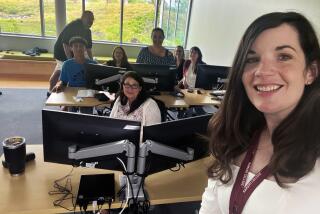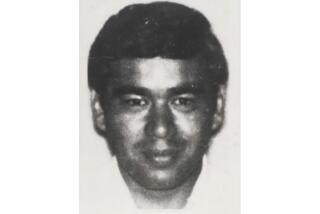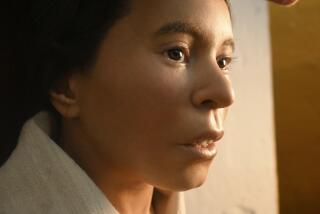‘Paleo Kid’ Yields New Clues to Man’s Past
- Share via
CORVALLIS, Ore. — For decades, her remains languished in the Nevada State Museum in Carson City, her significance unrecognized.
Now the “paleo kid” may be ready to give up her story, opening a window on the world of a child living 9,400 years ago in present-day Nevada.
Concealed for millennia by a rock overhang in the arid desert, the remains are “absolutely the best preserved” specimen of an ancient child yet found in North America, said Douglas Owsley, head of the division for physical anthropology at the Smithsonian Institution’s National Museum of Natural History.
Tests on the woven, diamond-plaited mat wrapping the bones indicate that the 8- or 9-year-old girl was a contemporary of Spirit Cave Man, another ancient whose skeleton was found in 1940 in Nevada, wrapped in the same style shroud. More tests will be done on the girl to verify the early findings.
Like the 9,300-year-old Kennewick Man found last year on the banks of the Columbia River at Kennewick, Wash., the paleo kid’s skull and face exhibit features differentiating her from other early North Americans.
Together, Owsley said, the discoveries are reshaping the way scientists think North America was populated. The newest revelations support theories that people with Caucasoid features mixed with people of Mongoloid descent who may have migrated across a “land bridge” from Asia to North America. Where Kennewick Man and his brethren came from is a mystery.
Disclosures about the origin of remains closeted years ago in musty museum vaults also are used by scientists who argue against turning the oldest skeletons over to tribes for reburial as provided by the federal Native American Graves and Repatriation Act.
Owsley introduced the scientific world to the paleo kid last month at the 58th annual Biology Colloquium at Oregon State University, where the theme was “Who Were the First Americans?”
The girl was found in the late 1930s and given to an archeologist working for the Nevada state park system, Owsley said. She went into the Nevada State Museum collection, where her antiquity went unrecognized.
Ancient skeletons provide insights into the health, nutrition, lifestyles, environment and genetic relationships of ancient people, Owsley said. Using techniques unknown in the 1930s, scientists recently realized the paleo kid’s significance. New techniques will continue to push the boundaries of discovery, Owsley said, far surpassing the limits scientists faced when the paleo kid was found.
“It’s really quite a spectacular discovery,” he said. “The things we can learn today, they weren’t even dreaming of back then.”
Scientists have sued in U.S. District Court in Portland to block the U.S. Army Corps of Engineers from turning Kennewick Man over to Indian tribes seeking to rebury the bones. The scientists argue that federal law does not prohibit scientific study, which they say is necessary to determine whether Kennewick Man is related to any modern tribes.
The tribes seeking to rebury the bones consider studying the remains a desecration. They want to rebury the bones of the man they consider an ancestor as soon as possible. Late last month, a federal judge ruled that two Columbia Plateau tribes, the Nez Perce and the Confederated Tribes of the Umatilla Reservation, could intervene in the legal confrontation, enabling them to express their views in court.
“Our people’s traditional beliefs and practices teach us that we have an inherent responsibility to care for those who are no longer with us,” Horace Axtell, a Nez Perce leader, wrote in an affidavit supporting the tribes’ motion to intervene.
“Our traditional spiritual beliefs, practices and culture teach us that when a body goes into the ground, it is meant to stay there until the end of time.”
More to Read
Sign up for Essential California
The most important California stories and recommendations in your inbox every morning.
You may occasionally receive promotional content from the Los Angeles Times.










